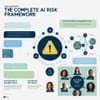The article argues that most organizations treat AI risk as a box‑checking exercise, focusing on surface‑level security controls that look impressive but don’t actually reduce exposure. This “security theatre” creates a false sense of safety, while real vulnerabilities—data bias, model drift, adversarial attacks—remain unaddressed. The author stresses that effective risk management must move beyond compliance checklists and instead embed measurable, scientific rigor into every stage of the AI lifecycle.
A robust framework starts with a clear taxonomy: identify assets (models, training data, endpoints), threats (model theft, data poisoning, inference‑time attacks), and impacts (financial loss, reputational damage, regulatory penalties). The next step is quantitative risk assessment—using techniques like Monte Carlo simulations, adversarial robustness scores, and fairness metrics—to turn abstract concerns into concrete probability and impact figures. This data‑driven approach enables prioritization and resource allocation that align with actual business risk.
Implementation requires continuous monitoring and feedback loops. The article highlights tools such as model‑explainability dashboards, automated drift detectors, and real‑time anomaly detection to catch degradation before it affects production. By integrating these tools into CI/CD pipelines, teams can enforce risk thresholds automatically, ensuring that any model that exceeds acceptable bias or vulnerability levels is blocked from deployment.
Finally, the author emphasizes governance and accountability. Clear ownership, documented risk‑acceptance criteria, and regular audits are essential to keep the framework alive. When risk is quantified and tied to measurable outcomes, organizations can transition from performative security gestures to a science‑backed risk culture that genuinely protects AI systems and the stakeholders they serve.


